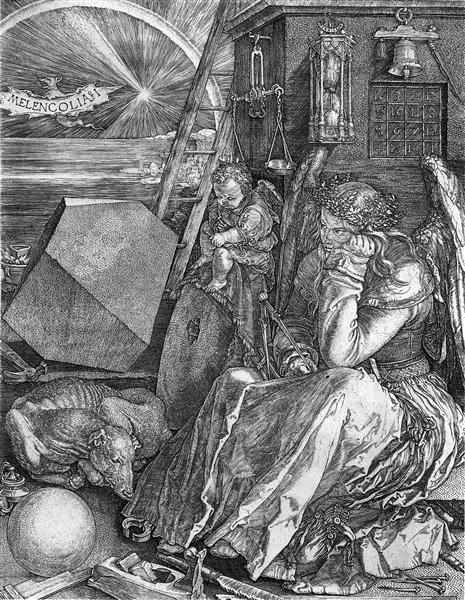Introduction ~ The Creative Spirit
To study the humanities is, in essence, to study creativity. The humanities is a single category that contains an enormous amount of material. It is comprised of the visual arts, architecture, literature and poetry, music, religion, dance, philosophy… all the ways that human beings use the arts to express ideas and explore meaning. The search for meaning is timeless. We do it. People in the past did it. What is new?
What is new is the insight we can garner from examining how human beings in different times and places used these art forms as a mode of inquiry, a way of expressing desire, love, connection, fear, hatred, hope …. yes, just like us.
For example, let’s take a look at a print by Albrecht Durer. As you can see, the title of this work is in the upper left corner: Melencolia. That is melancholy, to us. Melancholy is a state of mind one can fall into quite easily. We’ve all been there. It is a kind of sadness, a form of inactivity where you just can’t get yourself moving in any direction. But look closely at how Durer explores this state of mind via images that have symbolic impact. Imagine that the large figure is a human being. A human being with wings! He/she is poised, cheek in hand, pen at the ready, waiting for inspiration that … just… doesn’t…. come. Ponder the notion that human beings have wings but they often don’t use them. Frozen assets, perhaps? Even this person’s “genius,” the little winged being next to him, simply cannot get moving. They are both surrounded by things, tools, a ladder, a wheel, a scale, forms that are associated with math and geometry, tools for building, money, a vista and horizon. And in the state he is in, melancholy, he simply cannot move. Look above his head. Time is running out! Notice the grid of numbers. This is known as the “Magic Square” because no matter which direction you go to add up the numbers, across, diagonally, up, down… the numbers always add up to 34. This Magic Square has also cleverly presented the year of this work, which was 1514. So in this image, Durer has presented a keen examination of the state of melancholy. It’s not just sadness. It is a state of inertia when you are surrounded by extraordinary gifts and potential, but you just can’t see them.
 We can all identify with this. But look at the horizon. The sun is rising. There is a rainbow. Are these symbols of hope? There is a French saying, allors que je respire, je l’espere. So long as I breathe, I hope. That is timeless as well.
We can all identify with this. But look at the horizon. The sun is rising. There is a rainbow. Are these symbols of hope? There is a French saying, allors que je respire, je l’espere. So long as I breathe, I hope. That is timeless as well.
Please view and listen to Florence and the Machine as she expresses the feeling of loneliness, fear, and a kind of melancholy that comes with being an artist:
I feel like I’m about to fall
The room begins to sway
And I can hear the sirens
But I can’t walk away
Grab me by my ankles
I’ve been flying for too long
I couldn’t hide from the thunder
In the sky full of song
In what ways can you identify with this? Is a contemporary song easier for you to make connections with?
What are the ways these two works of art, the print from 1514 and the song from 2018, might converse with each other?
As we begin our journey into creativity from 1550 to the 21st century, remember that to study history is, in many ways, a study of our world today.

